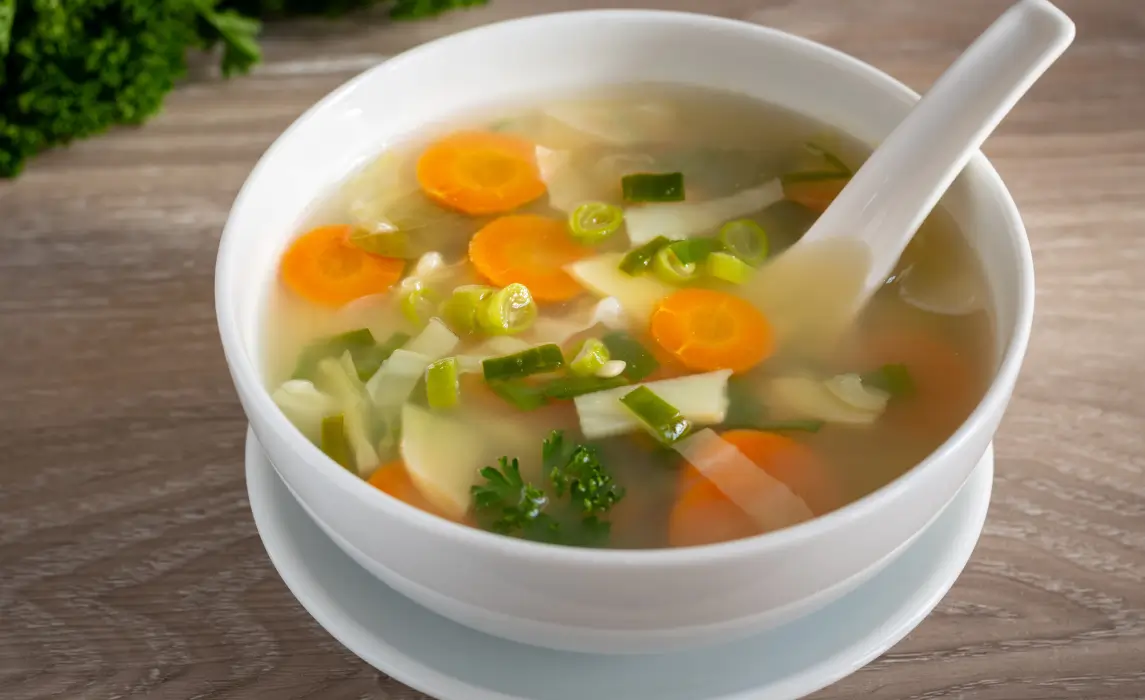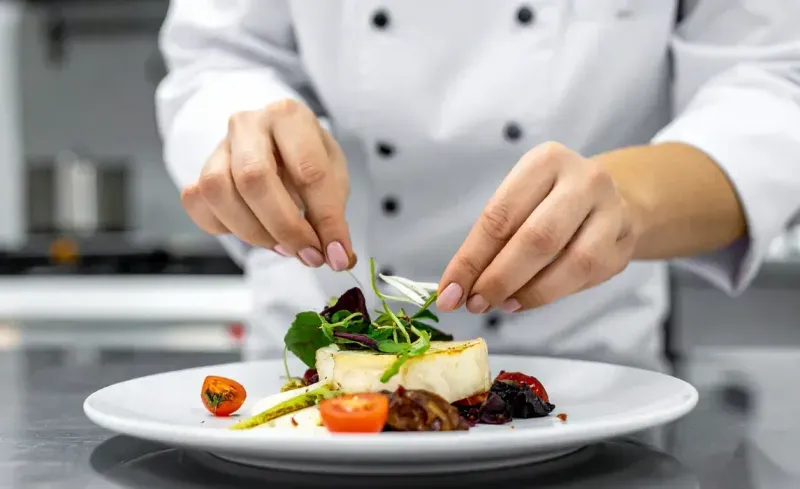Soup is one of humanity's oldest culinary innovations, dating back over 20,000 years to when we first made heat-resistant containers. What started as a practical method to extract nutrients evolved into thousands of recipes shaped by local ingredients and traditions. There's real science behind soup's comfort: the warmth activates your parasympathetic nervous system while steam aids hydration, but the deeper appeal is emotional—soup takes time, it's made for sharing, and it connects us to memories of being cared for. This guide organizes soups by cooking technique and texture rather than vague categories, so you'll understand what distinguishes a broth from a stock, why cultures favor different styles, and which type serves your specific need—whether you're meal-prepping, recovering from illness, or hosting guests. This isn't just a recipe list; it's a framework for understanding why soups exist the way they do.Retry
Clear Soups (Broths and Consommés)
Clear soups are exactly what they sound like—you can see straight through to the bottom of your bowl. But that transparency isn't just aesthetic; it's a sign of technique. These soups are built on liquid foundations where bones, meat, or vegetables simmer long enough to release their flavor and nutrients into water, then get strained out completely. The result is a clean, aromatic liquid that can stand alone or become the base for more complex dishes. If you've ever sipped miso soup at a Japanese restaurant or spooned into Italian stracciatella, you've experienced clear soup's elegant simplicity.
Broths: The Everyday Workhorse
Broths are the most approachable clear soups—typically simmered for 1-3 hours, which is short enough for a weeknight but long enough to extract real flavor. Chicken broth uses meat and bones together, giving you both richness and body without cloudiness. Beef broth tends to be darker and more robust because the bones are often roasted first, caramelizing proteins that add depth. Vegetable broth relies on aromatic vegetables like onions, carrots, and celery, plus herbs, making it lighter but still flavorful. The key difference from stock? Broths are seasoned and ready to eat as-is, while stocks are unsalted building blocks for other recipes. When you're sick and crave something soothing, or need to rehydrate after a workout, broth delivers nutrients and electrolytes in their most digestible form.
Consommé: When Broth Gets Dressed Up
Consommé is broth that's been clarified to crystal-clear perfection using a technique called a "raft"—a mixture of egg whites, ground meat, and vegetables that attracts impurities like a magnet as it simmers. The result is a soup so clear and refined it looks almost jewel-like in the bowl. Traditionally served at formal French dinners, consommé proves that restraint can be impressive. It's rarely made at home because the process is fussy, but if you order it at a high-end restaurant, you're tasting hours of labor condensed into a pristine, intensely flavored liquid. It's also a canvas—chefs float delicate garnishes like julienned vegetables, herbs, or a splash of sherry to add visual and flavor contrast without muddying the clarity.
When to Choose Clear Soups
Reach for clear soups when you want something light that won't weigh you down—before a heavy meal, when you're under the weather, or when you need hydration with flavor. They're also ideal for showcasing high-quality ingredients since there's nowhere to hide: fresh herbs, quality soy sauce, or a squeeze of citrus make a noticeable difference. In Asian cuisines, clear broths form the backbone of noodle soups like pho and ramen, where the broth quality determines the entire dish. In Western cooking, they're often the starting point for sauces, risottos, and braises. Understanding clear soups means understanding the foundation of countless other recipes.
Read Related Article: Food Presentation: Plate Like a Chef - Art & Plating Techniques
Master the art of food presentation with chef-level plating techniques. Learn how to plate like a pro using color, texture, balance, and creativity to turn every meal into a visual masterpiece.
Read More
Thick Soups
Thick soups are comfort in a bowl—the kind that clings to your spoon and fills you up. What makes them thick varies wildly: some use cream, others rely on pureed vegetables, and some get their body from potatoes or roux. Understanding these differences helps you choose the right soup for your dietary needs, cooking skills, and occasion.
Cream Soups: Rich, Velvety, and Misunderstood
Cream soups get their luxurious texture from dairy—usually heavy cream, milk, or a butter-flour roux called béchamel. The process typically starts with sautéing aromatics (onions, garlic, celery), adding your main ingredient (mushrooms, broccoli, tomatoes), then incorporating cream to create that signature velvety mouthfeel. Cream of mushroom became an American staple not just for eating, but as a cooking ingredient—condensed versions turned into quick sauces for casseroles. Cream of tomato pairs acidity with richness, which is why it's the classic grilled cheese companion. New England clam chowder loads cream with potatoes, bacon, and clams for a meal substantial enough to sustain fishermen through cold Atlantic shifts.
The Non-Dairy Revolution: You don't need dairy to achieve creaminess anymore. Coconut milk works beautifully in Thai-inspired soups, cashew cream (blended soaked cashews) mimics dairy's richness in vegan versions, and even pureed white beans or cauliflower can add body without any cream at all. This matters for the lactose-intolerant, vegan eaters, and anyone watching saturated fat—you're no longer stuck with thin, watery alternatives.
Pureed Soups: Smooth Texture, Bold Flavor
Pureed soups skip the cream entirely and get their thickness from the vegetables themselves, blended until silky. This technique works best with naturally starchy or fibrous ingredients: butternut squash, carrots, potatoes, cauliflower. The result is a soup that tastes intensely of its main ingredient because nothing's masking it. Roasting vegetables before blending adds caramelized depth—think roasted red pepper soup versus boiled. Tomato bisque sits in between pureed and cream soups, traditionally using both tomato puree and a touch of cream, though modern versions often skip the dairy.
Hot vs. Cold: Pureed soups work both ways. Hot versions like butternut squash are fall and winter staples, often finished with warming spices like nutmeg or cumin. Cold pureed soups like gazpacho flip the script—raw tomatoes, cucumbers, peppers, and onions blended with olive oil and vinegar create a refreshing, vegetable-forward soup perfect for summer heat. The trick with cold soups is seasoning aggressively; cold temperatures dull flavors, so they need more salt, acid, and punch than their hot counterparts.
Chowders: The Chunky Exception
Chowders break the "thick soup" rules—they're thick but intentionally chunky, never pureed. The name likely comes from the French "chaudière" (cauldron), and the style originated in New England fishing communities who turned the day's catch into hearty one-pot meals. What defines a chowder isn't the seafood (though clams are traditional)—it's the combination of a creamy or tomato-based broth thickened with potatoes, loaded with chunks of protein and vegetables.
The Great Chowder Divide: New England clam chowder uses cream, potatoes, and salt pork for a white, rich soup. Manhattan clam chowder swaps cream for tomatoes, creating a lighter, red-hued version with more acidity. The debate between them runs deep—Maine actually tried to outlaw tomatoes in clam chowder in 1939. Corn chowder follows the New England template but highlights sweet corn, often with bacon and bell peppers. The beauty of chowders is their flexibility—they're designed to use whatever's abundant, which is why you'll find salmon chowder in the Pacific Northwest and conch chowder in the Bahamas.
Practical Tip: Chowders thicken as they sit because the potato starch continues to absorb liquid. Always make them thinner than you think they should be, and keep extra broth or milk on hand for reheating leftovers.
Read Related Article: Easy Christmas Appetizer Ideas: Festive Finger Food for Your Party
Discover easy Christmas appetizer ideas that wow your guests! From festive finger foods to elegant holiday bites, these recipes make your party both delicious and stress-free.
Read More
Chunky/Hearty Soups
Chunky soups are meals disguised as soup—the kind where you need both a spoon and a fork, and one bowl actually fills you up. Unlike pureed or cream soups that prioritize smooth texture, these embrace the individual ingredients, letting each component keep its shape and identity. They're built for sustenance, designed by cultures that needed one pot to feed families or use up whatever was on hand.
Vegetable Soups: The Fridge-Cleaner That Became Iconic
Vegetable soup is democracy in a pot—there's no single "right" recipe because it's fundamentally about using what you have. The base usually starts with onions, carrots, and celery (the "holy trinity" in French cooking, or "mirepoix"), then branches out to whatever's seasonal: green beans, zucchini, tomatoes, cabbage, potatoes. What separates a great vegetable soup from a forgettable one is timing. Root vegetables go in first because they take longer to soften. Delicate vegetables like spinach or peas get added in the final minutes so they don't turn to mush. The broth matters too—a quality stock makes the difference between "leftover vegetable water" and something you'd actually crave. This is the soup to make when you're cleaning out your produce drawer before it goes bad, which is exactly how it originated in peasant kitchens across Europe.
Minestrone: Italy's Template for Adaptability
Minestrone proves that "vegetable soup" can have sophistication. The Italian approach adds pasta or rice for heartiness, beans for protein, and often finishes with a drizzle of olive oil and grated Parmesan that melts into the hot broth. Every region in Italy makes it differently—Milan's version includes rice and pancetta, Genoa stirs in pesto at the end, and southern versions lean heavily on tomatoes. The constant is this: minestrone is thick with vegetables and starches, creating a soup that's almost stew-like in substance. It's also traditionally made with a parmesan rind simmered in the broth, which adds umami depth without any extra cost—a trick you should steal for any vegetable-based soup. The name literally means "big soup," and it lives up to that promise.
Bean and Legume Soups: Protein-Packed and Budget-Friendly
Bean soups are kitchen workhorses—cheap, filling, and nutritionally complete when paired with grains or bread. Lentils, split peas, chickpeas, and white beans all turn into satisfying soups that improve with time as flavors meld. The key advantage of legumes in soup is that they naturally thicken the broth as they break down, creating body without cream or flour. Split pea soup with ham is the classic example—traditionally made with a leftover ham bone that adds smoky depth while the peas dissolve into a thick, porridge-like consistency. White bean and kale soup, popular in Tuscany, combines creamy cannellini beans with bitter greens and garlic for balance. Black bean soup in Latin American cooking often gets blended partially, leaving some beans whole for texture contrast.
The Ham Hock Secret: Many traditional bean soups use ham hocks or ham bones not just for flavor but because the collagen breaks down during long simmering, adding silky richness. If you're making vegetarian versions, a splash of liquid smoke and smoked paprika can approximate that depth, though you'll miss the body that collagen provides.
Read Related Article: Different Drink Glasses: Types of Glassware for Each Drink
Explore the different types of drink glasses and their perfect pairings. Learn which glassware suits wine, cocktails, beer, and more to elevate your drinking experience.
Read More
Meat and Poultry Soups: When Soup Becomes a Main Course
Chicken noodle soup is the Western world's medicinal standard for a reason—the collagen from chicken bones (especially if you use dark meat and include joints) creates a broth that's genuinely easier to digest than plain water, while the protein and carbs from chicken and noodles provide energy when you're depleted. The key to good chicken noodle soup is cooking the noodles separately and adding them to bowls individually; otherwise they absorb all the broth and turn gummy in leftovers. Egg noodles are traditional because they hold up better than Italian pasta.
Beef stew walks the line between soup and stew—it's liquid enough to be spooned but chunky enough to need chewing. The technique matters here: you brown the beef cubes first (this Maillard reaction creates flavor compounds that raw-cooked meat never develops), then simmer low and slow until the connective tissue breaks down into gelatin. That's what makes the meat tender and the broth glossy. Potatoes, carrots, and onions are standard, but the liquid—usually beef broth or red wine—does the heavy lifting. When reheated, beef stew actually tastes better because the flavors have more time to integrate, making it ideal for meal prep.
Why Hearty Soups Hit Differently: These soups satisfy in ways lighter versions can't because they provide complete nutrition in one bowl—protein, vegetables, starches, and fat all working together. They also tend to be high in gelatin from bones and connective tissue, which explains why they feel soothing to eat and leave you satisfied longer than carb-only meals.
International Soup Varieties
Soups tell you more about a culture than almost any other dish—they reveal what grows locally, what's considered medicinal, and how communities gather to eat. These aren't just "foreign versions" of soup; they represent entirely different philosophies about flavor, texture, and purpose.
Asian Soups: Broth as the Main Event
Pho (Vietnam): This beef noodle soup is all about the broth—simmered for 12+ hours with charred onions, ginger, star anise, and beef bones until it develops a clarity and depth that's almost sweet. The magic happens at the table: you add fresh herbs (Thai basil, cilantro, sawtooth coriander), bean sprouts, lime, and chili to customize each bite. Pho is traditionally breakfast food in Vietnam, valued for being light enough to start the day but substantial enough to fuel it. The difference between good and mediocre pho is entirely in the broth quality—there's nowhere to hide shortcuts.
Ramen (Japan): Unlike pho's clarity, ramen broths are often cloudy and rich, made by boiling bones so aggressively that fat and collagen emulsify into the liquid (tonkotsu style). But ramen's diversity is staggering—shoyu (soy sauce-based), miso (fermented soybean paste), and shio (salt-based) each create completely different flavor profiles. The noodles matter as much as the broth; they're alkaline, giving them a springy bite and slight yellow color. Ramen shops guard their broth recipes obsessively because that's their identity. Instant ramen is a bastardized version—convenient but nothing like the real thing.
Miso Soup (Japan): This is the opposite of ramen's intensity—a simple, delicate soup made with dashi (kombu seaweed and bonito flakes) and miso paste, typically served with tofu, wakame seaweed, and green onions. It's served at nearly every Japanese meal, including breakfast, because it's considered digestively beneficial. The probiotic miso paste never gets boiled (which would kill the beneficial bacteria), just whisked in at the end. This soup teaches you that "simple" doesn't mean "boring"—when ingredients are this clean, quality becomes everything.
Tom Yum (Thailand): Hot, sour, and aggressively aromatic, tom yum hits all your taste receptors at once—lemongrass, galangal, kaffir lime leaves, fish sauce, lime juice, and chilies create a broth that's simultaneously refreshing and intense. Tom yum goong (with shrimp) is the most common version. The soup isn't meant to be subtle; it's medicinal in Thai culture, believed to clear sinuses and boost immunity. Many Westerners find it overwhelmingly sour or spicy on first try, but it's calibrated for a climate where food needs bold flavors to cut through heat and humidity.
European Soups: Technique and Tradition
French Onion Soup (France): This is peasant food elevated through technique—caramelizing onions for 45+ minutes until they're mahogany and sweet, deglazing with wine, then simmering in beef stock before topping with bread and Gruyère cheese that gets broiled until bubbly. The slow caramelization is non-negotiable; it's where all the flavor comes from. Traditionally eaten late at night in Parisian markets, it's designed to warm you from the inside and absorb alcohol—hence why it's still popular in bistros at 2 AM.
Borscht (Eastern Europe): This beet soup exists in dozens of variations across Ukraine, Russia, and Poland, but the Ukrainian version is considered the original. Beyond the vibrant magenta color from beets, it includes cabbage, potatoes, and sometimes meat, finished with a dollop of sour cream that swirls into pink. Borscht can be served hot or cold, and the flavor is earthy-sweet with a tangy edge from vinegar or fermented beet juice (which also gives it probiotic benefits). It's deeply connected to identity—Ukraine's government actually applied for UNESCO protection of borscht as cultural heritage.
Mulligatawny (Britain/India): This curry-flavored soup is a colonial hybrid—British colonizers in India wanted soup (not a traditional Indian meal structure), so Indian cooks adapted by turning curry into soup form with coconut milk, lentils, chicken, and rice. The name comes from Tamil "milagu tanni" (pepper water). It's a reminder that some "traditional" dishes are actually cultural collisions, and it tastes better than its confused origins suggest—warming, mildly spiced, and substantial.
Latin American Soups: Celebration and Sustenance
Pozole (Mexico): This hominy-based soup is ceremonial—traditionally served at celebrations, made with pork or chicken, and topped with an entire salad bar of garnishes: shredded cabbage, radishes, oregano, lime, tostadas, avocado. The hominy (nixtamalized corn kernels) takes hours to soften and gives the soup a distinctive chewy texture. Red pozole gets its color from dried chilies; green from tomatillos and peppers; white has no added color. What makes pozole special is the interactive eating—everyone builds their bowl differently with the garnishes.
Sancocho (Caribbean/Latin America): Think of this as Latin America's chicken soup—a hearty, restorative stew made with various meats (chicken, beef, pork), starchy vegetables (yuca, plantains, potatoes, corn), and flavored with cilantro and local peppers. Every country has its version: Colombia's includes three types of potatoes, Panama's adds ñame (a tropical tuber), and Puerto Rico's uses sofrito. It's weekend food, made in massive pots for family gatherings. The magic is in the multiple starches, which each contribute different textures and break down at different rates to thicken the broth naturally.
Sopa de Lima (Mexico - Yucatán): Chicken soup gets a citrus makeover with bitter limes (a Yucatecan variety), topped with fried tortilla strips that soften into the broth. The broth is clear and light, flavored with charred tomatoes and habaneros that add heat without overwhelming. It's designed for the tropical Yucatán climate—refreshing but still comforting, proving that soup doesn't have to be heavy to be satisfying.
African and Middle Eastern Soups: Spice-Driven and Substantial
Harira (Morocco): This Ramadan staple is what breaks the daily fast—a tomato-based soup thickened with lentils and chickpeas, enriched with lamb or beef, and spiced with ginger, cinnamon, and turmeric. What makes it unique is the addition of "tedouira," a flour and water mixture whisked in at the end to create a slightly silky, thick texture. It's served with dates and chebakia (honey-soaked cookies) because the sweetness balances the savory, spiced soup after a day of fasting. Harira is nutritionally engineered to rehydrate and provide quick energy without overwhelming a sensitive stomach.
Chorba (North Africa/Middle East): This family of soups spans Algeria, Tunisia, Libya, and beyond—generally featuring lamb or chicken, vegetables, and small pasta or grains like freekeh. Algerian chorba frik uses cracked green wheat and gets its distinctive flavor from dried mint and ras el hanout (a spice blend with 20+ components). Unlike Western soups that simmer for hours, chorba comes together relatively quickly but packs intense flavor from spice layering. It's everyday food but also ceremonial, served to break fasts and celebrate weddings. The warmth comes from spices, not necessarily heat—cumin, coriander, and turmeric do the heavy lifting.
Why These Soups Matter: Each represents solutions to local challenges—hot climates get sour and spicy soups that refresh, cold regions develop rich broths that warm, and cultures with scarce meat create soups where a little protein stretches far with beans and grains. Understanding these soups means understanding how people have fed themselves for generations.
Read Related Article: Kids Halloween Party Ideas: Fun Halloween Parties
Discover fun and creative kids' Halloween party ideas! From spooky games to themed snacks and decorations, make your child’s Halloween celebration unforgettable.
Read More
Specialty Categories
Some soups defy easy classification—they're served cold when soup "should" be hot, they're sweet when soup "should" be savory, or they blur the line between soup and something else entirely. These categories reveal how flexible soup can be once you stop thinking of it as just a warm, savory liquid.
Cold Soups: Not Just Chilled Leftovers
Gazpacho (Spain): This Andalusian soup is designed for brutal summer heat—raw tomatoes, cucumbers, bell peppers, onions, and garlic blended with olive oil, vinegar, and bread (which acts as a thickener). It's served ice-cold and tastes like a liquid salad, refreshing rather than filling. The bread is the secret—it gives body and a subtle creaminess without any dairy. Traditional gazpacho is smooth, but modern versions sometimes leave it chunky. What surprises people is how satisfying cold soup can be when it's intentionally designed that way, not just yesterday's soup from the fridge. The acidity and fat from vinegar and olive oil make it feel complete despite being served cold.
Vichyssoise (France/America): Here's a plot twist—this "French" cold soup was actually invented by a French chef in New York in 1917. It's pureed leeks and potatoes with cream, served chilled and garnished with chives. The base recipe is essentially hot potato-leek soup, but something changes when you chill it—the flavors mellow, the cream becomes more prominent, and the texture turns almost silky. It's elegant enough for formal dinners but simple enough to make at home. The key is seasoning aggressively; cold temperatures dull your taste buds, so vichyssoise needs more salt and pepper than you'd think.
The Cold Soup Principle: Cold soups work best with high acidity (like gazpacho's vinegar) or high fat content (like vichyssoise's cream) because these elements remain pronounced even when chilled. That's why you can't just refrigerate any soup and expect it to taste good cold—most need heat to activate aromatics and carry flavors.
Dessert Soups: When Sweet Meets Liquid
Dessert soups sound bizarre to Western palates, but they're common across Scandinavia, Eastern Europe, and Asia. Fruit soups like Swedish blåbärssoppa (blueberry soup) are served hot or cold, thickened slightly with potato starch, and often accompanied by dumplings or cream. They're not quite compote, not quite beverage—something in between that works as dessert or even breakfast. In Chinese cuisine, sweet red bean soup and black sesame soup are warm, subtly sweet soups that end meals or provide comfort during cold weather. The texture is smooth and almost porridge-like, with just enough liquid to be spooned.
Chilled Fruit Soups: Hungarian cold sour cherry soup is served as a starter in summer—cherries, sugar, sour cream, and white wine create something that's simultaneously refreshing, tangy, and sweet. It's disorienting if you expect soup to be savory, but it works because the soup doesn't pretend to be dessert—it's fruit-forward and light.
Why They're Rare in Western Cuisine: American and Western European food culture draws hard lines between sweet and savory courses. Dessert soups challenge that boundary, which is why they feel novel or strange. But in cultures without those rigid categories, soup is just a vehicle—what you put in it determines whether it's a meal, a snack, or a sweet ending.
Read Related Article: Simple Syrup Recipe: Make Easy Cocktail Syrup Recipes
Learn how to make simple syrup at home with this easy recipe! Perfect for cocktails, mocktails, and desserts—customize it with flavors for every occasion.
Read More
Bisques: The Luxe Exception
Bisques are to regular seafood soup what consommé is to broth—refined, concentrated, and expensive. Traditionally made with lobster, crab, or shrimp, bisques follow a specific technique: shells are sautéed with aromatics, then simmered in stock to extract every bit of flavor before being strained out. The liquid gets thickened with rice or a roux, enriched with cream, and often finished with cognac or sherry. The result is intensely seafood-forward, velvety, and rich enough that a small bowl feels indulgent.
What Makes Bisque Different: It's not just "cream of seafood soup"—the shells are critical. Crustacean shells contain flavor compounds that only release under heat and pressure, which is why bisque tastes more concentrated than soup made with just the meat. Some recipes even call for grinding the shells into a paste before straining, maximizing extraction. Modern shortcuts use tomato paste for color and depth, but purists argue this misses the point. Real bisque should taste like the essence of the sea, not tomato soup with shrimp.
Practical Reality: Bisque is restaurant food for most people because it's labor-intensive and expensive. If you're making it at home, save shells every time you cook shrimp or lobster in the freezer until you have enough. The effort pays off—homemade bisque tastes nothing like the canned stuff.
Stews vs. Soups: Where's the Line?
The distinction seems obvious until you actually try to define it. The standard answer is "stews are thicker and have less liquid," but that falls apart quickly. Is chowder a soup or a stew? What about gumbo? Here's a better framework:
Soups are liquid-forward: The broth is essential, not just a byproduct. You could drink soup from a mug if you wanted. The solid ingredients swim in the liquid rather than sitting in it. Think chicken noodle soup, miso soup, or minestrone—the broth carries the dish.
Stews are ingredient-forward: The liquid is a cooking medium that becomes a sauce, but it's not the star. Stews are thick enough that a spoon stands up in them. The ratio flips—more solids than liquid. You serve stew over something (rice, polenta, bread) because it's concentrated. Beef stew, chili, and Irish stew fit here.
The Gray Zone: Some dishes intentionally blur the line. Gumbo can be soup-like or stew-like depending on who makes it. Sancocho is called a soup but eats like a stew. Hungarian goulash is labeled a stew in America but served as soup in Hungary. The truth is that liquid content exists on a spectrum, and different cultures draw the line in different places. Instead of obsessing over classification, focus on what the dish does—if you need a spoon and a bowl, call it soup. If you need a plate and a fork, it's probably stew. Everything else is just semantics.
Why This Matters: Understanding the difference helps you cook intuitively. Soups need seasoned, flavorful liquid because you're consuming all of it. Stews need the solid ingredients to be perfectly cooked because they're the main event. Knowing where your dish falls on the spectrum tells you what to prioritize.
FAQ
Beyond soup categories and techniques, these FAQs tackle the practical cooking, storage, and flavor issues that come up when you're actually making soup at home.
Can you freeze soup with dairy or potatoes, and how do you prevent texture problems?
Yes, but with modifications. Cream-based soups separate and turn grainy when frozen because fat molecules break apart. Potatoes turn mushy as freezing ruptures their cells. The fix: freeze the base without dairy and add cream when reheating, or puree potato soups completely before freezing so texture changes don't matter. Alternatively, add fresh potatoes after thawing. Coconut milk freezes better than dairy cream due to more stable fats. Broth-based soups with vegetables, beans, and meat freeze perfectly for 3-4 months. Always cool completely before freezing, leave headspace for expansion, and reheat slowly on the stovetop rather than microwaving.
Why does my homemade soup taste bland compared to restaurant soup?
Three fixable mistakes: insufficient salt (soup needs more than you think—salt at every stage, not just once), weak base (water instead of stock—add a parmesan rind, soy sauce, or miso for depth), and missing acid (finish with lemon juice or vinegar to brighten flavors). Restaurants also properly brown meat and roast vegetables before adding liquid, creating complex caramelized flavors. A drizzle of quality olive oil or butter at the end adds richness. Quick rescue: add a pinch of salt, squeeze of lemon, and drizzle of olive oil, then taste again.
How long does homemade soup actually last, and when should you throw it out?
Broth-based soups last 3-4 days refrigerated; cream-based soups 2-3 days; seafood soups only 2 days maximum. Bean soups often stretch to 4-5 days. Don't rely on smell alone—discard if you see any mold, detect sourness, or notice slimy texture. Cool soup rapidly in shallow containers within 2 hours of cooking to prevent bacterial growth. Reheat only portions you'll eat rather than the whole batch repeatedly. When uncertain, freeze instead—you get 3-4 months of safe storage. Soups with fresh herbs, greens, or pasta should be eaten sooner as these ingredients degrade quickly.







-p-800.webp)
.webp)
.webp)
